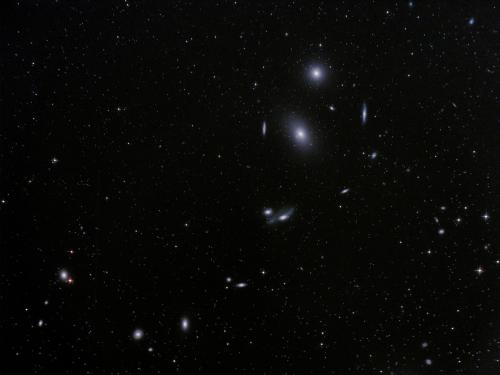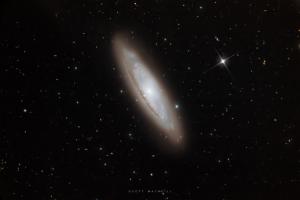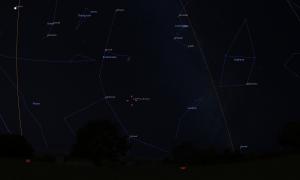Celebration of Space - March 1, 2024

Markarians Chain of galaxies. Image Credit: Brown University's Robert Horton captured this image, and Scott MacNeill processed the data.
Now that March is officially here, we are in the last days of winter in the Northern Hemisphere. Even though your mind may be either still fixated on winter storms, or daydreaming about open windows and beach days, the springtime brings a lot of interesting phenomena to the night sky. For starters, springtime brings galaxies to the night sky.
Often called Galaxy Season, springtime will bring the constellations Leo, Virgo, and Coma Berenices. It is along the intersection of these three constellations that the heart of the Virgo Galactic Supercluster resides. The supercluster is made up of at least 100 galaxy groups, including the Virgo Cluster and the Local Group – which we are part of. When pointing a telescope into this region of the sky from a super dark location like Ninigret Park, galaxies start to pop up everywhere, with some areas showing up to 10 galaxies in the field of view depending on aperture and magnification of the viewing device. The best way to start exploring the supercluster is to find the tail star of Leo – Denebola, the north-most star of Virgo – Vindemiatrix, and the faint cluster of stars that make up Coma Berenices – Berenice’s hair. Make a triangle with these three objects and direct your telescope into the center of that triangle, and start to pan around until you happen upon a galaxy. Take a moment to check out our Galaxies photo journal, as most of these are captured during springtime.
Springtime also brings the best time of the year to spot the Northern Lights, which is certainly the media’s favorite celestial item to completely botch! Around the Equinoxes, Earth’s lack of tilt towards or away from the Sun, allows for a higher number of charged particles in the solar wind to penetrate Earth’s magnetic field. Considering that the Sun has been extremely active this year as we approach solar maximum, the prospect of an Aurora-causing CME (Coronal Mass Ejection) is very likely. A quick note of advice: Don’t drive south to see the Northern Lights! Being that Frosty Drew is situated on the south coast of Rhode Island, traveling to Frosty Drew to see the Northern Lights is an instant failure. Instead, head up to New Hampshire, Maine, or Vermont to catch a view. Additionally, don’t go hiking all the way up there just because Fox News or CNN says so, wait until a reputable science organization puts out a notice. Otherwise, you’ll be up there every couple of days cursing the media.
One of the weird phenomena we observe in the springtime night sky is how fast the constellations seem to advance. When we say advance, we mean how fast the constellations move from the east to the west before passing below the horizon and out of view for the year. In reality, the sky does not advance any faster in the Northern Hemisphere spring than it does any other time of the year, but the effect is present. The cause of this effect is the rapidly changing sunset times. As we move through spring, the Sun continues to set later and later. This will result in constellations that were visible overhead two weeks ago, to no longer be visible overhead because the Sun has not set yet, and by the time the Sun does set, the constellations have now moved further into the western sky. We experience the opposite effect in the autumn, when the Summer Triangle asterism just seems to stick around for months!
Regardless of how you celebrate the coming springtime, be sure to take a moment to check out the night sky. See if you can spot the fast advancement of springtime constellations, as well as taking note of the placement of the Big Dipper, which will pass through the zenith during the spring. Let’s hope for clearer sky conditions this spring as well, considering we have the amazing solar eclipse coming in 38 days time.
Last Friday we wrote about the prospects of spotting Comet 12P/Pons-Brooks in the daytime sky during the April 8, 2024 total solar eclipse. Well this still remains a good prospect, but for those looking to catch a view of Comet 12P in the evening sky, the coming twelve days appear to be the best times to catch a view. Of course, in Southern New England, we have over seven days of rain coming, so we just aren’t allowed to have nice things here. But if you are outside of this mess, then you just may catch a good view of the comet.
Viewing Comet 12P at this time will require a telescope, or possibly binoculars. The best times to observe will be around 7:00 pm, after astronomical twilight ends. The Moon will be moving into its new phase on March 10, 2024, after which we will start to see the thin crescent in the evening sky. The first couple of days after the new Moon will be acceptable, but as the Moon gets brighter, the comet will become harder to see. The direction to look will be NW, at about 21° over the horizon. In a telescope or binoculars it will look like a cloud or glowing spot. As of today, the comet is reported to be as bright as magnitude 6.5, which is in the binocular range. Over the coming days, the comet will continue to brighten. Since Comet 12P is known for producing outbursts, there is a good chance the comet will become visible to the naked eye. So keep your eye to the sky, and if you see it, please let all of us in Southern New England know, because we can’t.
Last week, China’s space station – Tiangong, returned to the evening sky over our region, offering up fantastic visible passes during easy to observe hours of the day. Well passes continue this weekend and through next week. Sadly, Southern New England residents aren’t allowed to observe satellites at this time, but everyone else may have a chance. Here are a few notable pass times of Tiangong over the Northeast for the next seven days:
Fri, Mar 1 at 6:58 pm, starting in the WSW, rising to 67°, heading towards the ESE, and into orbital sunset ← Awesome pass!
Sat, Mar 2 at 7:33 pm, starting in the W, rising to 41°, and into orbital sunset.
Sun, Mar 3 at 6:32 pm, starting in the W, rising to 84°, heading towards the E, and into orbital sunset ← Awesome pass!
Mon, Mar 4 at 7:07 pm, starting in the W, rising to 87°, heading towards the E, and into orbital sunset ← Awesome pass!
Tue, Mar 5 at 7:42 pm, starting in the W, rising to 33°, and into orbital sunset
Wed, Mar 6 at 6:41 pm, starting in the W, rising to 84°, heading towards the ESE, and into orbital sunset ← Awesome pass!
Thu, Mar 7 at 7:16 pm, starting in the W, rising to 46°, and into orbital sunset
Look at that list of amazing passes we are going to miss in Southern New England! If you reside outside of the rain bomb of the next week, be sure to step outside and catch a view of Tiangong passing over. Note that these times will work for the Northeast region, but are specific for Southern New England. For daily pass times of bright satellites over our region, visit the Frosty Drew Daily Satellite Pass Prediction Utility. Tiangong is listed as CSS (TIANHE).
- Author:
- Scott MacNeill
- Entry Date:
- Mar 1, 2024
- Published Under:
- Scott MacNeill's Columns





